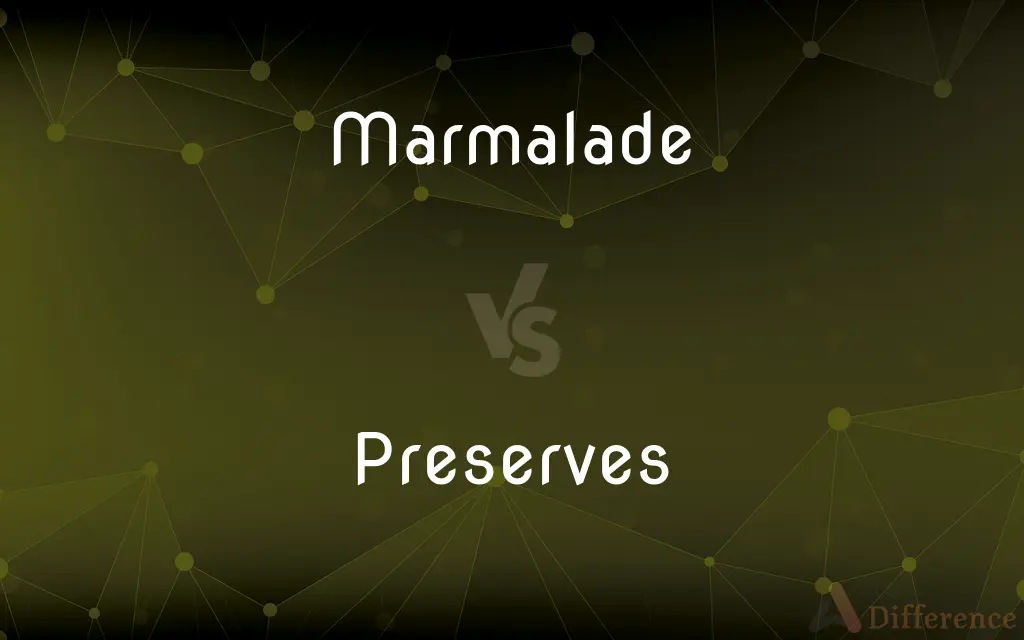Marmalade vs. Preserves — What's the Difference?
By Urooj Arif & Fiza Rafique — Published on March 2, 2024
Marmalade is a fruit preserve made from citrus fruits, known by its inclusion of peel, having a distinct bitter-sweet flavor. Preserves is a broader category of fruit spreads made from chunks of fruit in a gel-like base, typically sweeter and less chunky.

Difference Between Marmalade and Preserves
Table of Contents
ADVERTISEMENT
Key Differences
Marmalade is traditionally made from citrus fruits like oranges, lemons, limes, and grapefruits, incorporating both the juice and the peel, which gives it a distinctive bitter-sweet taste and texture. It is often used as a spread for toast or as a flavoring agent in baking and cooking. Preserves, on the other hand, can be made from a wide variety of fruits, including berries, peaches, plums, and apricots, and are characterized by large pieces of fruit or whole fruits suspended in a soft jelly or syrup base.
The preparation of marmalade involves cooking the fruit and peel with sugar and water, sometimes with added pectin to aid in gelling. This process highlights the natural bitterness of the citrus peel, a hallmark of marmalade's flavor profile. Preserves are made by gently cooking fruit and sugar, preserving larger chunks of fruit in a clear, thick syrup. The fruit in preserves is more recognizable in its original form compared to jams or jellies.
Marmalade is unique among fruit spreads for its use of citrus peel, which not only contributes to its flavor but also its texture. The peel adds a slight chewiness and complexity not found in other fruit spreads. In contrast, preserves aim to maintain the fruit's natural shape and texture as much as possible, offering a more straightforward fruit flavor with less textural complexity than marmalade.
In culinary use, marmalade's bitter-sweet flavor profile makes it suitable for both sweet and savory dishes, enhancing recipes with its depth of flavor. Preserves, with their sweeter, more straightforward fruit taste, are typically used in sweet applications like topping for desserts, breads, and pastries, although they can also be incorporated into sauces and glazes for savory dishes.
Both marmalade and preserves serve the purpose of fruit conservation and offer a way to enjoy seasonal flavors year-round, but their differences in ingredients, texture, and taste cater to a wide range of culinary preferences and applications, reflecting the diversity and versatility of fruit spreads.
ADVERTISEMENT
Comparison Chart
Base Fruit
Citrus fruits (oranges, lemons, etc.)
Variety of fruits (berries, peaches, etc.)
Texture
Contains peel, offering a chewy texture
Contains large pieces or whole fruit, softer texture
Flavor
Bitter-sweet, complex
Sweet, straightforward fruit flavor
Cooking Process
Cooked with peel, sometimes with added pectin
Fruit cooked in sugar, maintaining shape
Culinary Uses
Suitable for both sweet and savory dishes
Primarily used in sweet applications
Compare with Definitions
Marmalade
A citrus-based preserve including peel for a bitter-sweet taste.
Orange marmalade is a popular spread for morning toast.
Preserves
Fruit spread with large pieces or whole fruit in syrup.
Strawberry preserves are perfect for filling pastries.
Marmalade
Can be chunky or finely cut, depending on the peel.
Chunky marmalade offers a robust texture and flavor.
Preserves
Sweeter and less chunky than jams.
Apricot preserves provide a smooth, fruity topping for pancakes.
Marmalade
Used in baking and cooking for its unique flavor.
Lemon marmalade can be a tangy filling for cakes.
Preserves
A way to enjoy seasonal fruits year-round.
Berry preserves capture the summer's flavors for winter enjoyment.
Marmalade
Adds complexity to sauces and glazes.
A spoonful of marmalade can elevate a simple chicken glaze.
Preserves
Versatile in sweet and some savory dishes.
Raspberry preserves can add sweetness to a vinaigrette.
Marmalade
Often homemade with seasonal citrus fruits.
Homemade grapefruit marmalade brings a fresh taste to breakfast.
Preserves
Maintains the fruit's natural shape and texture.
Peach preserves showcase the fruit's delicate flavor and texture.
Marmalade
A clear, jellylike preserve made from the pulp and rind of fruits, especially citrus fruits.
Preserves
To prepare (food) for storage or future use, as by canning or salting.
Marmalade
A kind of jam made with citrus fruit, distinguished by being made slightly bitter by the addition of the peel and by partial caramelisation during manufacture. Most commonly made with Seville oranges, and usually qualified by the name of the fruit when made with other types of fruit.
Lime marmalade
Thick cut marmalade
Preserves
To treat fruit or other foods so as to prevent decay.
Marmalade
Ellipsis of orange marmalade
Preserves
Often preserves Fruit cooked with sugar to protect against decay or fermentation.
Marmalade
A preserve or confection made of the pulp of fruit, as the quince, pear, apple, orange, etc., boiled with sugar, and brought to a jamlike consistency.
Preserves
Fruit preserved by cooking with sugar
Marmalade
A preserve made of the pulp and rind of citrus fruits
Common Curiosities
Can marmalade be used in savory dishes?
Yes, its bitter-sweet flavor can enhance the taste of savory dishes.
Are preserves the same as jam?
No, preserves have larger fruit pieces, while jam is made from crushed fruit and is more uniform in texture.
Can you make marmalade with non-citrus fruits?
Traditionally, marmalade is made with citrus fruits, though some modern variations may incorporate non-citrus elements.
What makes marmalade different from other fruit spreads?
Marmalade includes citrus peel, giving it a distinctive bitter-sweet flavor.
Is marmalade healthier than preserves?
Healthiness depends on the sugar content and fruit used; both can be part of a balanced diet in moderation.
Do marmalade and preserves have the same shelf life?
Both can have long shelf lives when properly canned and stored, but this may vary based on sugar content and preservation method.
What's the best way to store marmalade and preserves?
In a cool, dark place before opening and refrigerated after opening.
Can you make preserves without added sugar?
Yes, but sugar helps in preservation and gelling; alternatives may require different preservation methods.
Are all marmalades orange flavored?
No, marmalade can be made from any citrus fruit, offering a variety of flavors.
Can marmalade be made without the peel?
Removing the peel would make it closer to a jelly than traditional marmalade.
Can preserves be used in cooking?
Yes, they can be used to sweeten sauces, dressings, and glazes.
Is there a preference for using marmalade or preserves in baking?
The choice depends on the desired flavor and texture; marmalade adds a bitter-sweetness, while preserves add sweetness and fruit pieces.
Why is pectin sometimes added to marmalade?
Pectin helps thicken the spread, especially in low-pectin citrus fruits.
Why are preserves sometimes preferred for pastries?
Their large fruit pieces and sweeter taste complement the sweetness of pastries.
How do you serve preserves?
Preserves can be served as a spread, filling, or topping for various dishes.
Share Your Discovery

Previous Comparison
Coach vs. Teacher
Next Comparison
Kobo Sage vs. Kobo Libra 2Author Spotlight
Written by
Urooj ArifUrooj is a skilled content writer at Ask Difference, known for her exceptional ability to simplify complex topics into engaging and informative content. With a passion for research and a flair for clear, concise writing, she consistently delivers articles that resonate with our diverse audience.
Co-written by
Fiza RafiqueFiza Rafique is a skilled content writer at AskDifference.com, where she meticulously refines and enhances written pieces. Drawing from her vast editorial expertise, Fiza ensures clarity, accuracy, and precision in every article. Passionate about language, she continually seeks to elevate the quality of content for readers worldwide.
















































